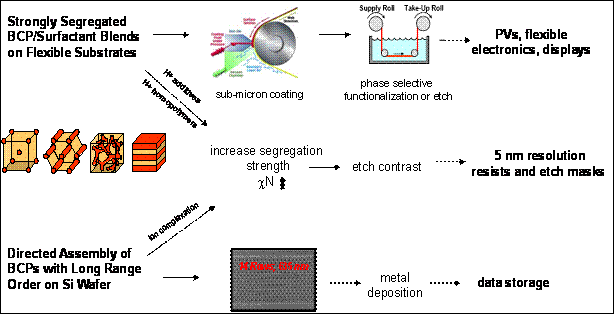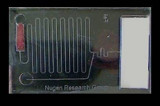- Home
- Research
- Education & Outreach
- Facilities
- Industry
Test Bed 1: Self Assembled Polymer Templates for Device Applications
The rapid generation of highly-ordered arrays of nanoscopic elements with periodicities of <30 nm render the self-assembly of BCPs ideal scaffolds and templates for nanofabrication. When one considers the cost, resolution and feature size limitations of current top-down methods, BCPs are extremely attractive. There are, however, several crucial challenges to enable a broad-based adaptation of BCPs in nanomanufacturing. This test bed identified, addressed and resolved some of these impediments through fundamental and process-oriented research to create a tool kit that can be broadly applied and demonstrated for specific applications.
Process Schemes
While built on a common theme of BCP templating the test bed developed platform solutions for two types of processes having very different requirements. The first is high-value Si wafer-based processing for addressable media or applications that demand low defect rates and perfection in lateral order. These processes are largely insensitive to BCP materials costs. The challenges here include understanding the role of topography and surface functionality in determining template order, reducing processing time, developing methodologies that employ process friendly and environmentally acceptable solvents and developing metrological tools for the rapid assessment of order over large areas. The second platform is the production of high-volume, cost-sensitive products (e.g., organic electronics, photovoltaics and flexible displays) that require high-rate processing, low materials cost, and an ability to functionalize or modify the BCP template. The challenges for these applications include the further development of low cost, well ordered surfactant/homopolymer blend templates developed by the CHM, the development of high speed, high reliability coating processes for roll to roll processes, stabilization, and chemical functionalization of the films. A cross cutting challenge for both applications involves increasing the strength of segregation of the template components via the incorporation of additives and homopolymers that exhibit strong preferential interactions with one of the copolymer segments. The schematic below illustrates the processes and their associated challenges. 













